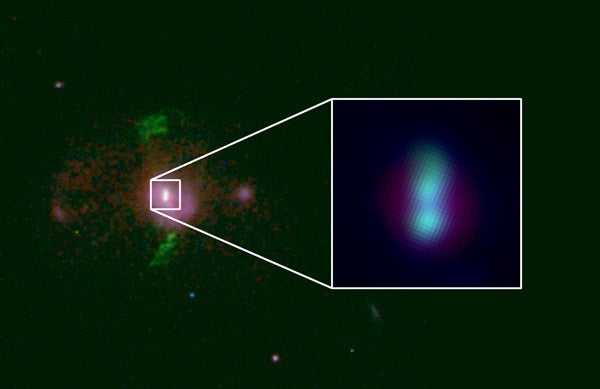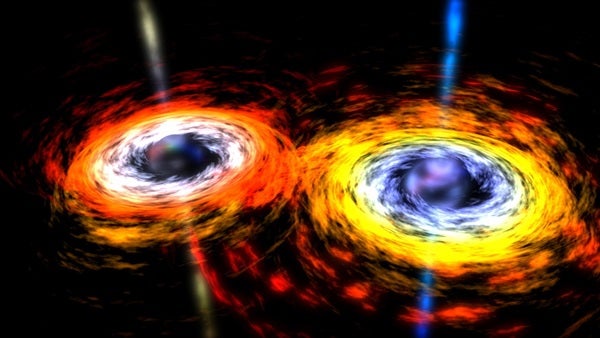This particular pair, each more massive than 800 million Suns, lies in a galaxy 2.5 billion light-years away. The galaxy itself is a merger remnant — all that’s left after two galaxies, each hosting a supermassive black hole, combined. A team led by Andy Goulding at Princeton University made the find using the Hubble Space Telescope and published their discovery July 10 in The Astrophysical Journal Letters.
Although astronomers often spot merging galaxies, they have never caught a pair of supermassive black holes actually clashing. And yet, “[merging] supermassive black hole binaries produce the loudest gravitational waves in the universe,” said study co-author Chiara Mingarelli, at the Flatiron Institute’s Center for Computational Astrophysics, in a press release. Supermassive black hole pairs, Mingarelli said, should send out gravitational waves “a million times louder” than those LIGO and VIRGO have already heard.
The final parsec problem
Supermassive black holes merge a little differently than their lower-mass counterparts. Because they start out very far apart — in two separate galaxies — it takes a long time for the black holes to meet in the middle of a galaxy merger. Astronomers believe the supermassive black holes slowly fall to the center of the final remnant galaxy and begin orbiting each other.
But there’s a catch. Some theories state that once the supermassive black holes reach a certain distance — 1 parsec, or about 3.2 light-years — apart, they stall out and stop. That’s because to get closer to each other, the black holes give away their energy to other objects, like gas, dust, and stars that get too close. But as the distance between the black holes shrinks, the available space for objects to swoop in and steal energy also shrinks. Within about 1 parsec, astronomers calculate there simply isn’t room to fit the amount of “stuff” required for the black holes to give away enough energy to close in and collide.
So from there, the black holes endlessly orbit each other, without coming any closer and merging. Astronomers call this the final parsec problem, because it’s difficult to get two supermassive black holes any closer than 1 parsec apart. Some theories state that only in cases where a third supermassive black hole is present, such as when three galaxies merge, is it possible to for a supermassive black hole merger to occur.
So, why not look for supermassive black holes less than 1 parsec apart to see if it can happen? Astronomers certainly would if they could, but at the great distances of other galaxies, current telescopes simply can’t separate two objects that are so close together. They look like one object. To add insult to injury, merging supermassive black holes don’t produce their deafening gravitational waves until they’re closer than 1 parsec apart, on that final approach. Even if it does happen, it’s rare, so it’s not unusual that gravitational waves from a supermassive black hole merger haven’t been heard yet.
“It’s a major embarrassment for astronomy that we don’t know if supermassive black holes merge,” said co-author Jenny Greene at Princeton. “For everyone in black hole physics, observationally this is a long-standing puzzle that we need to solve.”
What, then, can astronomers do to determine whether the final parsec problem is really a problem? If the theories are wrong and there is no problem, supermassive black hole pairs should approach each other and merge frequently enough to create a background “hum” of gravitational waves. “This noise is called the gravitational wave background, and it’s a bit like a chaotic chorus of crickets chirping in the night,” Goulding said. “You can’t discern one cricket from another, but the volume of the noise helps you estimate how many crickets are out there.” But this hum is outside the hearing range of LIGO and VIRGO, though astronomers are looking forward to projects like LISA, a space-based gravitational wave detector that will “hear” at frequencies current instruments cannot.
Alternatively, astronomers can use pulsars — the rapidly spilling remnants of massive stars that have collapsed into neutron stars instead of black holes — to pick up on the passage of gravitational waves. Passing gravitational waves stretch and shrink space-time as they go, which would disrupt very slightly the regular blips we receive from pulsars. This disruption would amount to a shift in the received signal of only a few hundred nanoseconds over the course of ten years or so, but if astronomers can catch such a change, it might also help them determine whether supermassive black holes can approach each other and merge.
Time limit
This particular pair of supermassive black holes was spotted at about 430 parsecs (1,400 light-years) apart and won’t make their final approach for 2.5 billion years. That number should sound familiar — they’re in a galaxy 2.5 billion light-years away, meaning that if they’re going to collide, it’s likely happening about now. But since gravitational waves travel at the speed of light, astronomers won’t see the event for another 2.5 billion years, if it even happened.
Nonetheless, this pair offers a window into merging supermassive black holes that astronomers today can use to learn more about the process, how it proceeds, and most importantly, how often it happens. Assuming there is no final parsec problem, the team used the information provided by this discovery to calculate how many pairs of supermassive black holes might be merging close enough for LIGO and VIRGO to hear their final thunderclap within a few years. They estimate there are just over 100 pairs of supermassive black holes spiraling close enough to merge that current gravitational wave observatories could detect. Based on that estimate, if astronomers don’t detect a supermassive black hole merger within about five years, the team says, it could mean the final parsec problem is a hurdle that even supermassive black holes can’t clear.











